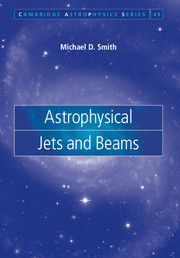Book contents
- Frontmatter
- Contents
- Preface
- 1 Introduction
- 2 Detection and measurement
- 3 The dynamical toolbox
- 4 Observations of extragalactic jets
- 5 Jets in galactic nuclei
- 6 Jets from young stars and protostars
- 7 Jets associated with evolved stars
- 8 Jets within the solar system
- 9 Jet launching
- 10 Jet propagation
- 11 The astrophysical jet
- References
- Index
11 - The astrophysical jet
Published online by Cambridge University Press: 05 March 2012
- Frontmatter
- Contents
- Preface
- 1 Introduction
- 2 Detection and measurement
- 3 The dynamical toolbox
- 4 Observations of extragalactic jets
- 5 Jets in galactic nuclei
- 6 Jets from young stars and protostars
- 7 Jets associated with evolved stars
- 8 Jets within the solar system
- 9 Jet launching
- 10 Jet propagation
- 11 The astrophysical jet
- References
- Index
Summary
From the first eight chapters, we conclude that the subject of astrophysical jets has seen observational advances over the last twenty years that take it almost beyond recognition in breadth and depth. The penultimate two chapters have shown how the major theories from the 1980s have been developed and adapted but not dismissed. Yet, there are long-standing debates which have not found a resolution and new issues which stretch our understanding.
The challenging themes can be listed under the following headings. We still need to gather evidence for:
The process of formation and launch
The collimation and acceleration
The propagation, structure and stability
The contents, both near and far from the driving source.
Here, rather than providing a long list of questions, we focus on some specific hot issues relevant to the general subject: the composition, regulation, feedback and unification.
Composition
The physical parameters, such as the energy, speed, mass flux and abundances of jet material, can often be constrained after identifying the radiation process. However, invisible components, whose presence has not yet been settled, may be flowing out adjacent to the radiating material or mixed in on the particle scale. For example, in the observed warm atomic and cold molecular jets from young stars and protostars, there may be more outflowing mass in the form of cold neutral atomic gas (Nisini et al., 2005). In addition, dust internal to the jet avoids direct detection (Dionatos et al., 2009).
- Type
- Chapter
- Information
- Astrophysical Jets and Beams , pp. 203 - 208Publisher: Cambridge University PressPrint publication year: 2012

